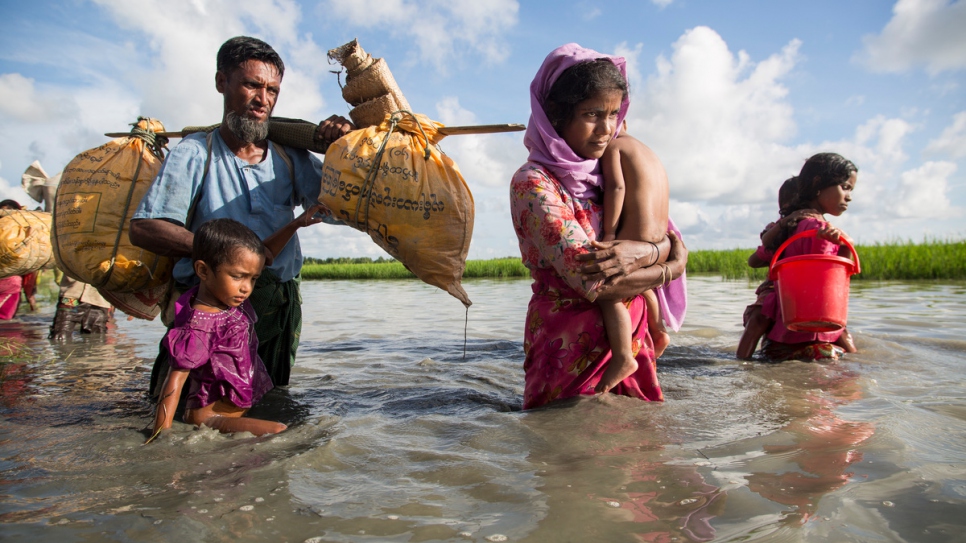UNHCR’s annual Global Trends report shows an average of one person was displaced every two seconds in 2017, with developing countries most affected. | UNHCR Report
A Rohingya family wades through water crossing the border from Myanmar into Bangladesh.
© UNHCR/Roger Arnold
Wars, violence and persecution uprooted record numbers of men, women and children worldwide last year, making a new global deal on refugees more critical than ever, according to a UNHCR report published today.
The UN Refugee Agency’s annual Global Trends study found 68.5 million people had been driven from their homes across the world at the end of 2017, more people than the population of Thailand.
Refugees who have fled their countries to escape conflict and persecution accounted for 25.4 million. This is 2.9 million more than in 2016, also the biggest increase UNHCR has ever seen in a single year.
New displacement is also growing, with 16.2 million people displaced during 2017 itself, either for the first time or repeatedly. That is an average of one person displaced every two seconds. And overwhelmingly, it is developing countries that are most affected.
“My message to the world is I don’t want to be a refugee. I want us to be able to go back to our home.”
Leading the displacement during the year was the crisis in the Democratic Republic of the Congo, the war in South Sudan and the flight into Bangladesh from Myanmar of hundreds of thousands of Rohingya refugees.
Among them was grandmother Mutaybatu, 55, who fled on foot.
“We walked for 10 days and then we crossed over by boat,” she said, speaking in a refugee settlement in Bangladesh. “It was a journey of hardship, we had no food, we ate occasionally what we could find like herbs and weeds, leaves of trees.”
The number of asylum-seekers awaiting the outcome of their applications for refugee status had risen by about 300,000, to 3.1 million, by the end of December 2017. People displaced inside their own country accounted for 40 million of the total, slightly fewer than the 40.3 million in 2016.
“We are at a watershed, where success in managing forced displacement globally requires a new and far more comprehensive approach so that countries and communities aren’t left dealing with this alone,” UN High Commissioner for Refugees Filippo Grandi said.
UNHCR’s Global Trends report is published worldwide each year ahead of World Refugee Day on 20 June, and tracks forced displacement based on data gathered by UNHCR, governments, and other partners.
However, Grandi found hope in a new blueprint for responding to refugee situations, pioneered by 14 countries. A new Global Compact on Refugees, seeking closer international cooperation in response to refugee crises, will be ready for adoption by the United Nations General Assembly in a matter of months.
“No one becomes a refugee by choice; but the rest of us can have a choice about how we help.”
“Today, on the eve of World Refugee Day, my message to member states is please support this,” he said. “No one becomes a refugee by choice; but the rest of us can have a choice about how we help.”
The findings in the Global Trends report challenge some of the perceptions about forced displacement.
Among these is the notion that the world’s displaced are mainly in countries of the global north. The data shows the opposite to be true – with fully 85 per cent of refugees in developing countries, many of which are desperately poor and receive little support to care for these populations.
Four out of five refugees remain in countries next door to their own.
Eighteen-year-old Dinai But But Ruach fled his native South Sudan for neighbouring Ethiopia in 2017.
“South Sudan is not good for us. There was fighting, shooting, children being taken away. Houses, including mine, were destroyed,” says Dinai, who is among 5,000 refugees living in Gure Shombola Camp, a new site which opened during the year to meet the influx.
Large-scale displacement across borders is also less common than the 68 million global displacement figure suggests. Almost two-thirds of those forced to flee are internally displaced people who have not left their own countries. Of the 25.4 million refugees, just over a fifth are Palestinians under the care of UNRWA.
Of the remainder, for whom UNHCR is responsible, two-thirds come from just five countries: Syria, Afghanistan, South Sudan, Myanmar and Somalia. An end to conflict in any one of these has potential to significantly influence the wider global displacement picture.
As with the number of countries producing large-scale displacement, the number of countries hosting large numbers was also comparatively few. Turkey remained the world’s leading refugee hosting country in terms of absolute numbers, with a population of 3.5 million refugees, mainly Syrians.
“There was fighting, shooting, children being taken away. Houses, including mine, were destroyed.”
Lebanon hosted the largest number of refugees relative to its national population. In all, 63 per cent of all refugees under UNHCR’s responsibility were in just 10 countries.
Sadly, solutions remained in short supply. Wars and conflict continued to be the major drivers, with little visible progress towards peace. About 5 million people were able to return to their homes in 2017, with most returning from internal displacement. Among these were people returning under duress, or to fragile contexts.
“My message to the world is I don’t want to be a refugee,” says Mutaybatu, whose flight followed years of persecution, culminating in the murder of her husband.
“I want us to be able to go back to our home in Myanmar, but I want to be assured of safety and to live in peace … not always living in fear of the next attack.”
Additional reporting by Firas Al-Khateeb in Bangladesh and Diana Diaz in Ethiopia.

